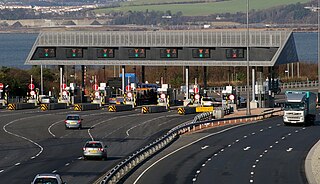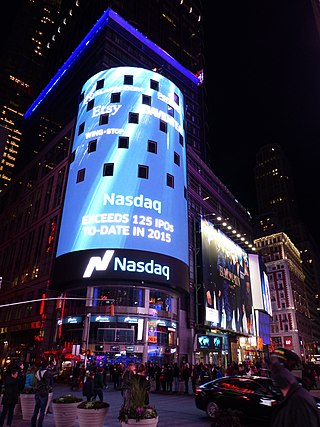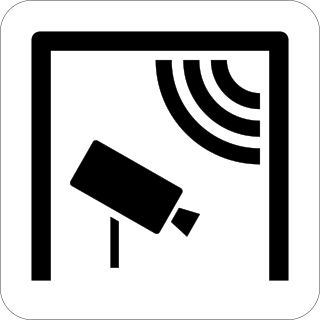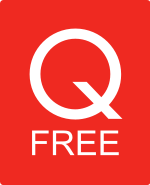
Transport in Norway is highly influenced by Norway's low population density, narrow shape and long coastline. Norway has old water transport traditions, but road, rail and air transport have increased in importance during the 20th century. Due to the low population density, public transport is somewhat less built out in rural areas of Norway, however public transport in, and around cities is well developed.

The CAC 40 is a benchmark French stock market index. The index represents a capitalization-weighted measure of the 40 most significant stocks among the 100 largest market caps on the Euronext Paris. It is a price return index. It is one of the main national indices of the pan-European stock exchange group Euronext alongside Euronext Amsterdam's AEX, Euronext Brussels' BEL20, Euronext Dublin's ISEQ 20, Euronext Lisbon's PSI-20 and the Oslo Bors OBX Index. It is an index without dividends. Cotation every working day from 9:00 a.m. to 5:30 p.m.. It is updated every 15 seconds.

Oslo Airport, alternatively referred to as Oslo Gardermoen Airport or simply Gardermoen, is the international airport serving Oslo, Norway, the capital and most populous city in the country. A hub for Norwegian Air Shuttle, Scandinavian Airlines and Widerøe, it connects to 26 domestic and 158 international destinations.

Road pricing are direct charges levied for the use of roads, including road tolls, distance or time-based fees, congestion charges and charges designed to discourage the use of certain classes of vehicle, fuel sources or more polluting vehicles. These charges may be used primarily for revenue generation, usually for road infrastructure financing, or as a transportation demand management tool to reduce peak hour travel and the associated traffic congestion or other social and environmental negative externalities associated with road travel such as air pollution, greenhouse gas emissions, visual intrusion, noise pollution and road traffic collisions.
Trondheim Toll Scheme or Trondheim Package was the result of that in the 1980s politicians and road authorities in Trondheim, Norway wanted to accelerate the investments in roads and motorways around the city through an investment package and toll scheme to ease construction and generate more funds. Between 1991 and 2005, there were more than 20 toll plazas throughout the city that help finance the new roads. Toll plazas will still remain east of the city at least until 2012. The toll collection is administrated by Trøndelag Veifinans.

The Norwegian railway system comprises 4,109 km of 1,435 mm track of which 2,644 km is electrified and 274 km double track. There are 697 tunnels and 2,760 bridges.

The Norwegian Institute of Technology was a science institute in Trondheim, Norway. It was established in 1910, and existed as an independent technical university for 58 years, after which it was merged into the University of Trondheim as an independent college.

Electronic toll collection (ETC) is a wireless system to automatically collect the usage fee or toll charged to vehicles using toll roads, HOV lanes, toll bridges, and toll tunnels. It is a faster alternative which is replacing toll booths, where vehicles must stop and the driver manually pays the toll with cash or a card. In most systems, vehicles using the system are equipped with an automated radio transponder device. When the vehicle passes a roadside toll reader device, a radio signal from the reader triggers the transponder, which transmits back an identifying number which registers the vehicle's use of the road, and an electronic payment system charges the user the toll.

Nordic Semiconductor ASA was founded in 1983 and is a Norwegian fabless technology company with its headquarters in Trondheim, Norway. The company specializes in designing ultra-low-power wireless communication semiconductors and supporting software for engineers developing and manufacturing Internet of Things (IoT) products.

MagCom was a Norwegian manufacturer of cellular GSM handsets. The company, located in Oslo, was founded in 1999. In its various phases, around 200 million NOK were invested in the company. Insight Capital Partners, Telenor Venture and Anders Wilhelmsen AS were the largest investors. The company's single product was the triple band MagCom cellular phone, on sale from April 2001.

Nasdaq, Inc. is an American multinational financial services corporation that owns and operates three stock exchanges in the United States: the namesake Nasdaq stock exchange, the Philadelphia Stock Exchange, and the Boston Stock Exchange, and seven European stock exchanges: Nasdaq Copenhagen, Nasdaq Helsinki, Nasdaq Iceland, Nasdaq Riga, Nasdaq Stockholm, Nasdaq Tallinn, and Nasdaq Vilnius. It is headquartered in New York City, and its president and chief executive officer is Adena Friedman.

Autopass is an electronic toll collection system used in Norway. It allows collecting road tolls automatically from cars. It uses electronic radio transmitters and receivers operating at 5.8 GHz (MD5885) originally supplied by the Norwegian companies Q-Free and Fenrits. Since 2013 Kapsch and Norbit supplied the transponders. In 2016 the Norwegian Public Roads Administration revealed that they had chosen Norbit and Q-Free as suppliers of Autopass-transponders the next four years.

Open road tolling (ORT), also called all-electronic tolling, cashless tolling, or free-flow tolling, is the collection of tolls on toll roads without the use of toll booths. An electronic toll collection system is usually used instead. The major advantage to ORT is that users are able to drive through the toll plaza at highway speeds without having to slow down to pay the toll. In some installations, ORT may also reduce congestion at the plazas by allowing more vehicles per hour/per lane.
A toll road is a road over which users may travel over on payment of a toll, or fee. Tolls are a form of use tax that pays for the cost of road construction and maintenance, without raising taxes on non-users. Investor's bonds necessary for the construction of the roads are issued and sold with the expectation that the bonds will be paid back with user tolls. The toll roads may be run by government agencies that have bond issuing authority and/or private companies that sell bonds or have other sources of finance. Toll roads are usually a government guaranteed road monopoly that guarantees limited or no competing roads will be built by government agencies for the duration of the bonds. Private toll roads built with money raised from private investors in expectation of making money from the tolls probably dominated early toll roads. Government sponsored toll roads often guarantee a minimum payment to the bond holders if traffic volume and toll collections are less than predicted. If the toll authority is a private company there is often a maximum amount of fees that they may extract from users. Toll road operators are typically responsible for maintaining the roads. After the bonds are paid off the road typically reverts to the government agency that authorized the road and owns the land it was built on. Like most government taxes it is not unusual for tolls to continue to be charged after the bonds have been paid off.
The Norwegian National Rail Administration was a government agency responsible for owning, maintaining, operating and developing the Norwegian railway network, including the track, stations, classification yards, traffic management and timetables. Safety oversight was the duty of the Norwegian Railway Inspectorate, while numerous operating companies run trains on the lines; the largest being the state owned passenger company Vy and the freight company CargoNet.
SuperOffice is a European supplier of business-to-business customer relationship management (CRM) software. SuperOffice was founded in 1989 by Une Amundsen. He renamed the company "Superland" and refers to himself as "The King of Superland".
The Kapsch Group, headquartered in Vienna, Austria, is an international corporation specializing in telematics, information technology and telecommunication.

Road tolling to finance bridges, tunnels and roads has a long history in Norway. The cities Oslo, Bergen and Trondheim introduced toll rings between 1986 and 1991 as a means to discourage urban traffic and to finance infrastructure projects around those cities. Today toll rings circumscribe Oslo, Kristiansand, Stavanger, Haugesund, Bergen, Askøy, Bodø, Harstad, Grenland, Førde and Trondheim. Besides toll rings, road tolls are installed to finance certain road projects, and often also on the existing road to discourage people from using it. Some tolls use congestion pricing and/or environmentally differentiated toll rates.
Volue is a Norwegian technology company working in the field of energy, power grid, water, and infrastructure, founded in March 2020.













